Staff Development: Exploring Supervisory Leadership Influence
VerifiedAdded on 2023/06/03
|10
|2719
|348
Essay
AI Summary
This essay examines the influence of supervisory leadership on staff development, particularly within Singapore's education system. It highlights the government's initiatives to enhance staff capabilities, focusing on instructional leadership and the development of educarers for young children. The essay addresses challenges such as resistance to change, the need for extensive staff training, and the importance of vocational training. It also discusses the positive impacts of innovative methods, including career advancement opportunities and improved learning experiences for children. The role of supervisory leadership in establishing a vision, providing resources, and motivating staff is emphasized, along with initiatives like the ECDA fellow programme and the Lien Foundation's efforts to train preschool principals. The essay concludes that while challenges exist, the adoption of innovative techniques positively impacts the country by meeting changing needs and fostering overall development. Desklib provides access to similar solved assignments and study resources for students.
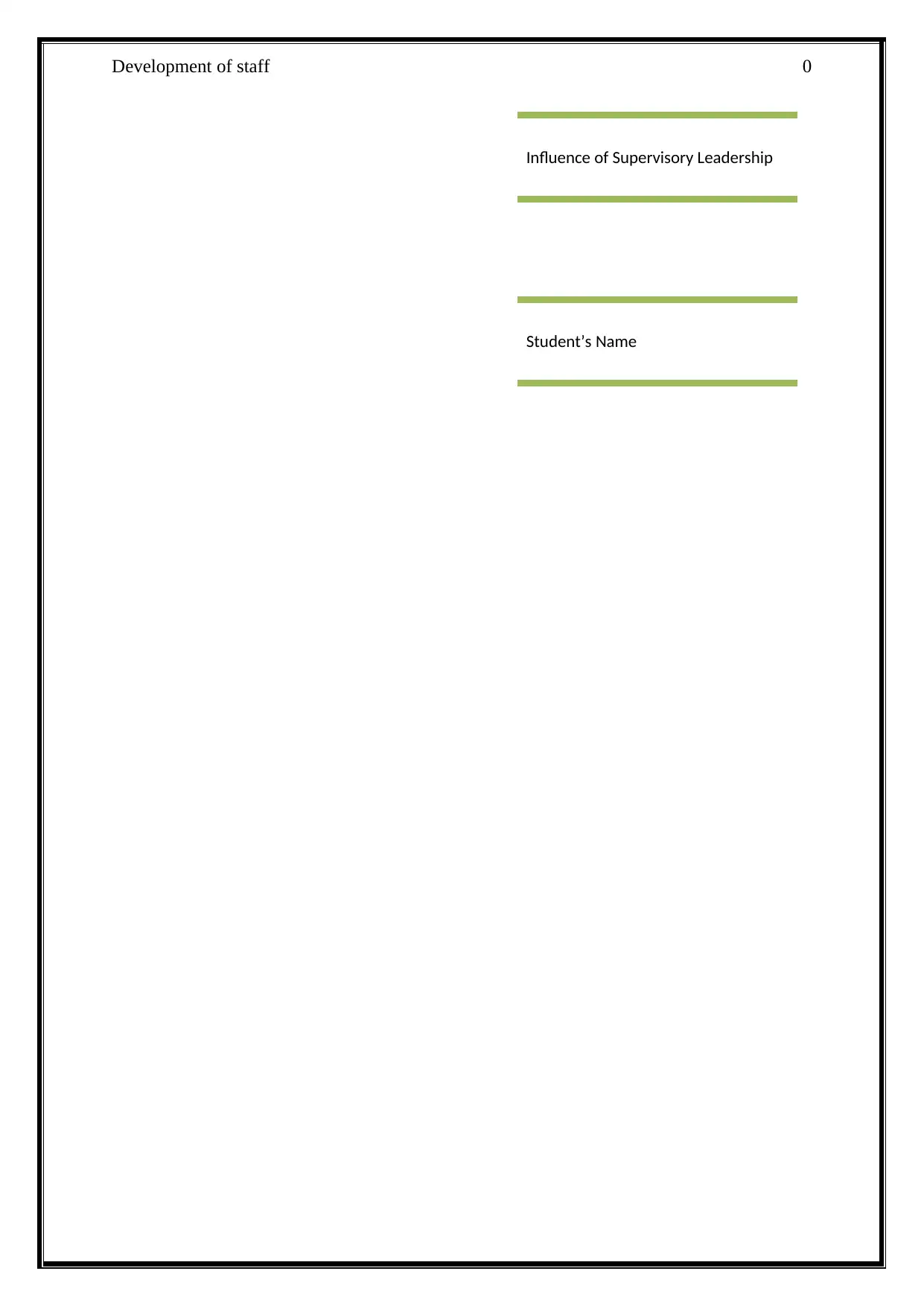
Development of staff 0
Influence of Supervisory Leadership
Student’s Name
Influence of Supervisory Leadership
Student’s Name
Paraphrase This Document
Need a fresh take? Get an instant paraphrase of this document with our AI Paraphraser
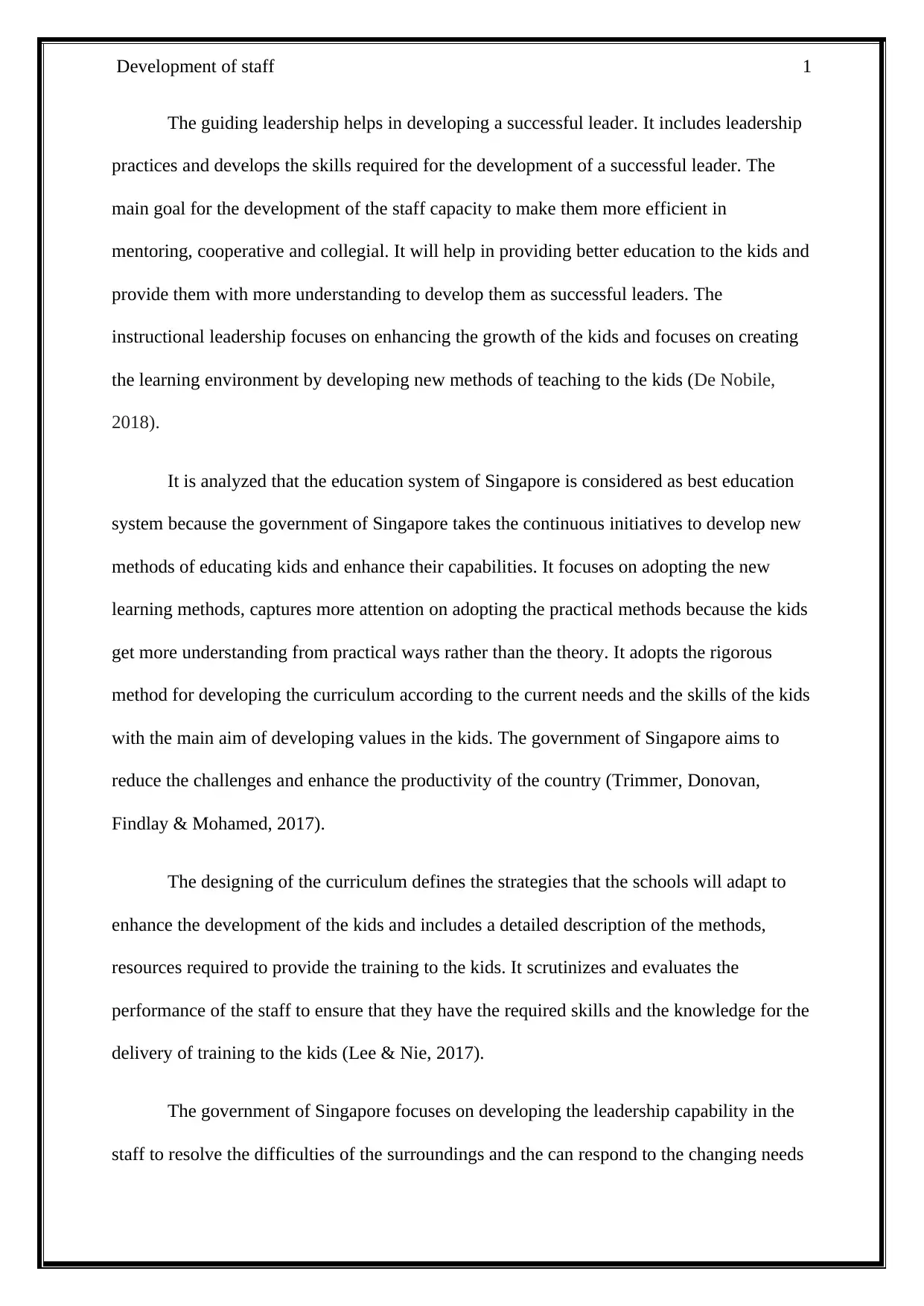
Development of staff 1
The guiding leadership helps in developing a successful leader. It includes leadership
practices and develops the skills required for the development of a successful leader. The
main goal for the development of the staff capacity to make them more efficient in
mentoring, cooperative and collegial. It will help in providing better education to the kids and
provide them with more understanding to develop them as successful leaders. The
instructional leadership focuses on enhancing the growth of the kids and focuses on creating
the learning environment by developing new methods of teaching to the kids (De Nobile,
2018).
It is analyzed that the education system of Singapore is considered as best education
system because the government of Singapore takes the continuous initiatives to develop new
methods of educating kids and enhance their capabilities. It focuses on adopting the new
learning methods, captures more attention on adopting the practical methods because the kids
get more understanding from practical ways rather than the theory. It adopts the rigorous
method for developing the curriculum according to the current needs and the skills of the kids
with the main aim of developing values in the kids. The government of Singapore aims to
reduce the challenges and enhance the productivity of the country (Trimmer, Donovan,
Findlay & Mohamed, 2017).
The designing of the curriculum defines the strategies that the schools will adapt to
enhance the development of the kids and includes a detailed description of the methods,
resources required to provide the training to the kids. It scrutinizes and evaluates the
performance of the staff to ensure that they have the required skills and the knowledge for the
delivery of training to the kids (Lee & Nie, 2017).
The government of Singapore focuses on developing the leadership capability in the
staff to resolve the difficulties of the surroundings and the can respond to the changing needs
The guiding leadership helps in developing a successful leader. It includes leadership
practices and develops the skills required for the development of a successful leader. The
main goal for the development of the staff capacity to make them more efficient in
mentoring, cooperative and collegial. It will help in providing better education to the kids and
provide them with more understanding to develop them as successful leaders. The
instructional leadership focuses on enhancing the growth of the kids and focuses on creating
the learning environment by developing new methods of teaching to the kids (De Nobile,
2018).
It is analyzed that the education system of Singapore is considered as best education
system because the government of Singapore takes the continuous initiatives to develop new
methods of educating kids and enhance their capabilities. It focuses on adopting the new
learning methods, captures more attention on adopting the practical methods because the kids
get more understanding from practical ways rather than the theory. It adopts the rigorous
method for developing the curriculum according to the current needs and the skills of the kids
with the main aim of developing values in the kids. The government of Singapore aims to
reduce the challenges and enhance the productivity of the country (Trimmer, Donovan,
Findlay & Mohamed, 2017).
The designing of the curriculum defines the strategies that the schools will adapt to
enhance the development of the kids and includes a detailed description of the methods,
resources required to provide the training to the kids. It scrutinizes and evaluates the
performance of the staff to ensure that they have the required skills and the knowledge for the
delivery of training to the kids (Lee & Nie, 2017).
The government of Singapore focuses on developing the leadership capability in the
staff to resolve the difficulties of the surroundings and the can respond to the changing needs
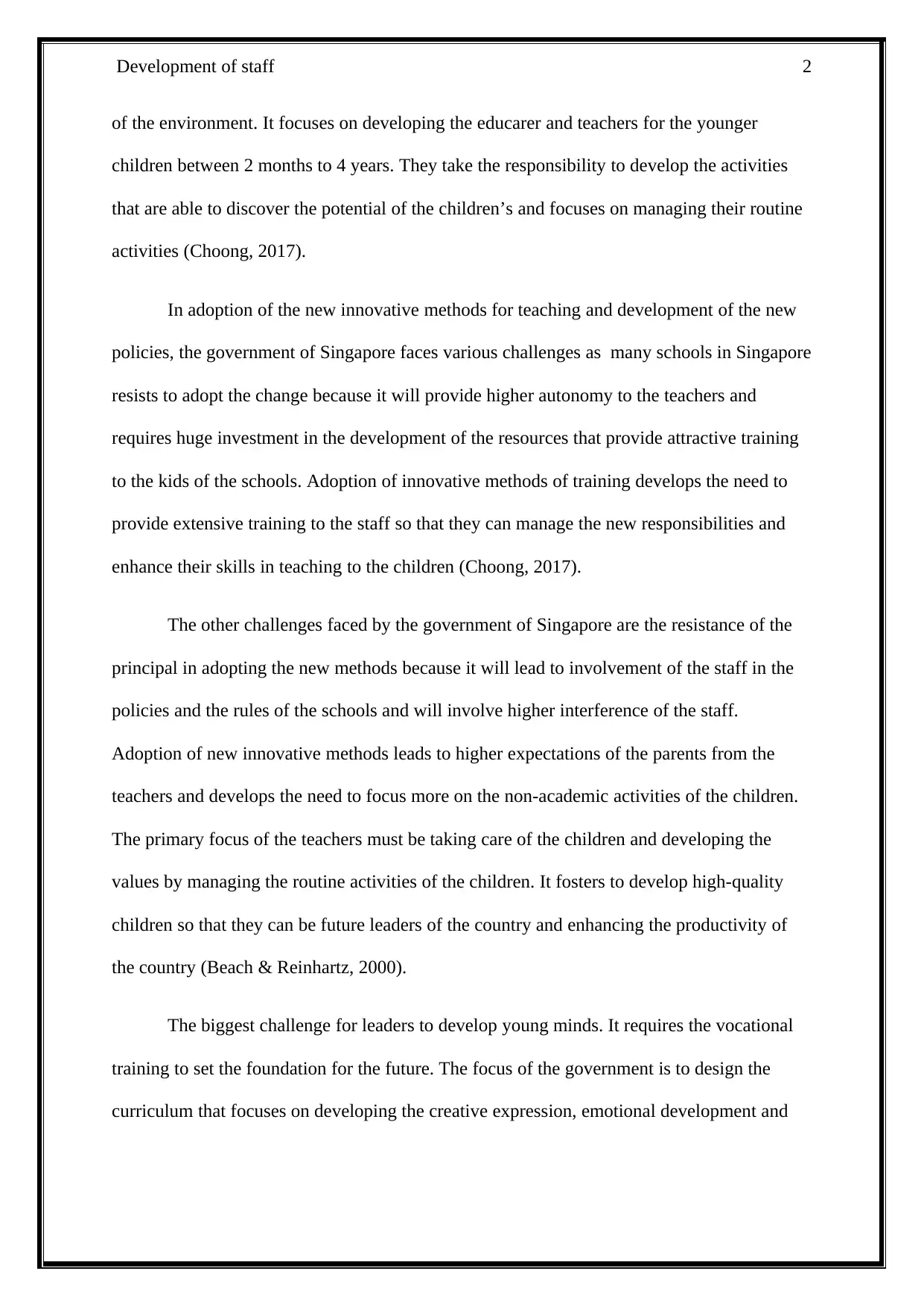
Development of staff 2
of the environment. It focuses on developing the educarer and teachers for the younger
children between 2 months to 4 years. They take the responsibility to develop the activities
that are able to discover the potential of the children’s and focuses on managing their routine
activities (Choong, 2017).
In adoption of the new innovative methods for teaching and development of the new
policies, the government of Singapore faces various challenges as many schools in Singapore
resists to adopt the change because it will provide higher autonomy to the teachers and
requires huge investment in the development of the resources that provide attractive training
to the kids of the schools. Adoption of innovative methods of training develops the need to
provide extensive training to the staff so that they can manage the new responsibilities and
enhance their skills in teaching to the children (Choong, 2017).
The other challenges faced by the government of Singapore are the resistance of the
principal in adopting the new methods because it will lead to involvement of the staff in the
policies and the rules of the schools and will involve higher interference of the staff.
Adoption of new innovative methods leads to higher expectations of the parents from the
teachers and develops the need to focus more on the non-academic activities of the children.
The primary focus of the teachers must be taking care of the children and developing the
values by managing the routine activities of the children. It fosters to develop high-quality
children so that they can be future leaders of the country and enhancing the productivity of
the country (Beach & Reinhartz, 2000).
The biggest challenge for leaders to develop young minds. It requires the vocational
training to set the foundation for the future. The focus of the government is to design the
curriculum that focuses on developing the creative expression, emotional development and
of the environment. It focuses on developing the educarer and teachers for the younger
children between 2 months to 4 years. They take the responsibility to develop the activities
that are able to discover the potential of the children’s and focuses on managing their routine
activities (Choong, 2017).
In adoption of the new innovative methods for teaching and development of the new
policies, the government of Singapore faces various challenges as many schools in Singapore
resists to adopt the change because it will provide higher autonomy to the teachers and
requires huge investment in the development of the resources that provide attractive training
to the kids of the schools. Adoption of innovative methods of training develops the need to
provide extensive training to the staff so that they can manage the new responsibilities and
enhance their skills in teaching to the children (Choong, 2017).
The other challenges faced by the government of Singapore are the resistance of the
principal in adopting the new methods because it will lead to involvement of the staff in the
policies and the rules of the schools and will involve higher interference of the staff.
Adoption of new innovative methods leads to higher expectations of the parents from the
teachers and develops the need to focus more on the non-academic activities of the children.
The primary focus of the teachers must be taking care of the children and developing the
values by managing the routine activities of the children. It fosters to develop high-quality
children so that they can be future leaders of the country and enhancing the productivity of
the country (Beach & Reinhartz, 2000).
The biggest challenge for leaders to develop young minds. It requires the vocational
training to set the foundation for the future. The focus of the government is to design the
curriculum that focuses on developing the creative expression, emotional development and
⊘ This is a preview!⊘
Do you want full access?
Subscribe today to unlock all pages.

Trusted by 1+ million students worldwide
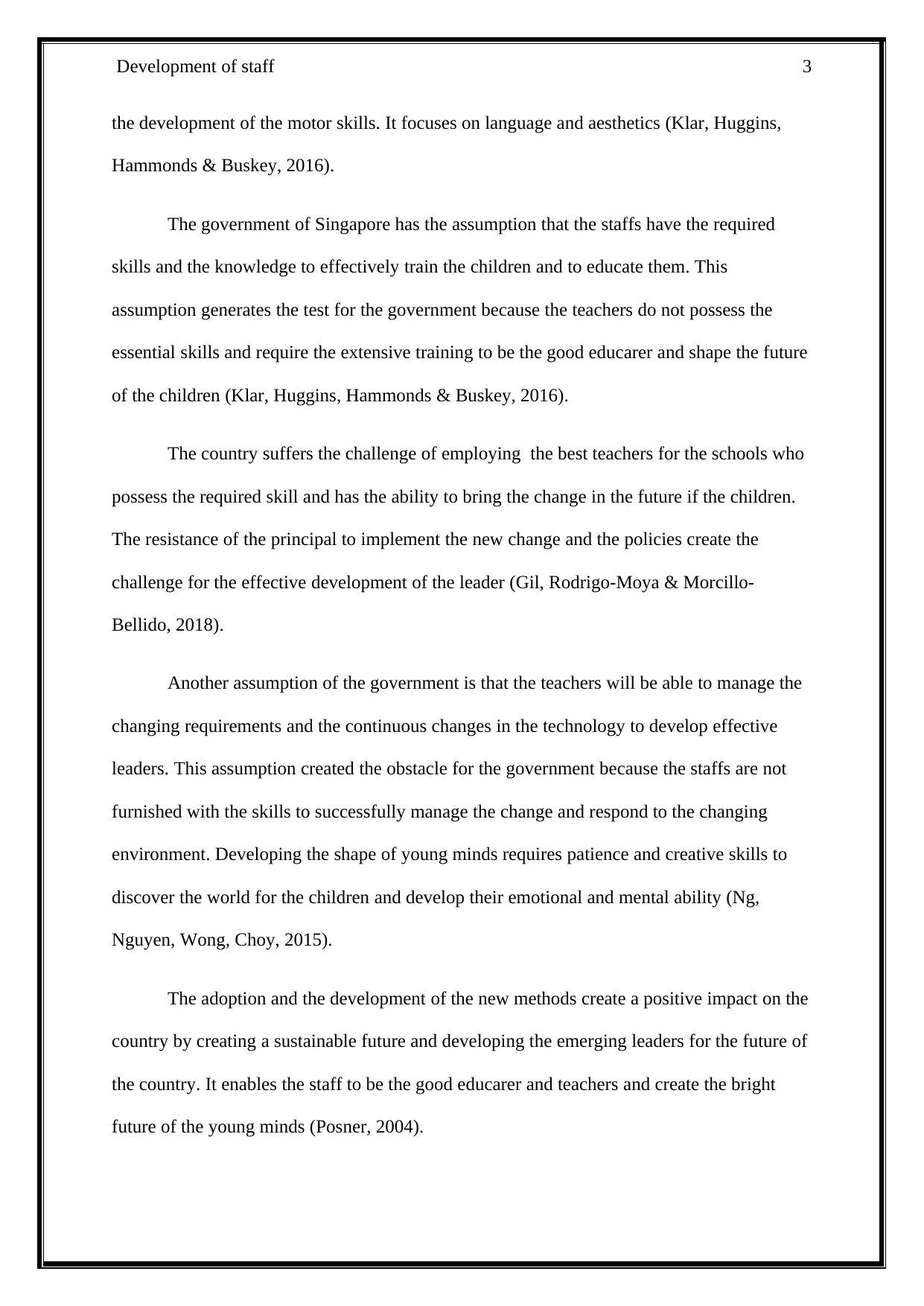
Development of staff 3
the development of the motor skills. It focuses on language and aesthetics (Klar, Huggins,
Hammonds & Buskey, 2016).
The government of Singapore has the assumption that the staffs have the required
skills and the knowledge to effectively train the children and to educate them. This
assumption generates the test for the government because the teachers do not possess the
essential skills and require the extensive training to be the good educarer and shape the future
of the children (Klar, Huggins, Hammonds & Buskey, 2016).
The country suffers the challenge of employing the best teachers for the schools who
possess the required skill and has the ability to bring the change in the future if the children.
The resistance of the principal to implement the new change and the policies create the
challenge for the effective development of the leader (Gil, Rodrigo-Moya & Morcillo-
Bellido, 2018).
Another assumption of the government is that the teachers will be able to manage the
changing requirements and the continuous changes in the technology to develop effective
leaders. This assumption created the obstacle for the government because the staffs are not
furnished with the skills to successfully manage the change and respond to the changing
environment. Developing the shape of young minds requires patience and creative skills to
discover the world for the children and develop their emotional and mental ability (Ng,
Nguyen, Wong, Choy, 2015).
The adoption and the development of the new methods create a positive impact on the
country by creating a sustainable future and developing the emerging leaders for the future of
the country. It enables the staff to be the good educarer and teachers and create the bright
future of the young minds (Posner, 2004).
the development of the motor skills. It focuses on language and aesthetics (Klar, Huggins,
Hammonds & Buskey, 2016).
The government of Singapore has the assumption that the staffs have the required
skills and the knowledge to effectively train the children and to educate them. This
assumption generates the test for the government because the teachers do not possess the
essential skills and require the extensive training to be the good educarer and shape the future
of the children (Klar, Huggins, Hammonds & Buskey, 2016).
The country suffers the challenge of employing the best teachers for the schools who
possess the required skill and has the ability to bring the change in the future if the children.
The resistance of the principal to implement the new change and the policies create the
challenge for the effective development of the leader (Gil, Rodrigo-Moya & Morcillo-
Bellido, 2018).
Another assumption of the government is that the teachers will be able to manage the
changing requirements and the continuous changes in the technology to develop effective
leaders. This assumption created the obstacle for the government because the staffs are not
furnished with the skills to successfully manage the change and respond to the changing
environment. Developing the shape of young minds requires patience and creative skills to
discover the world for the children and develop their emotional and mental ability (Ng,
Nguyen, Wong, Choy, 2015).
The adoption and the development of the new methods create a positive impact on the
country by creating a sustainable future and developing the emerging leaders for the future of
the country. It enables the staff to be the good educarer and teachers and create the bright
future of the young minds (Posner, 2004).
Paraphrase This Document
Need a fresh take? Get an instant paraphrase of this document with our AI Paraphraser
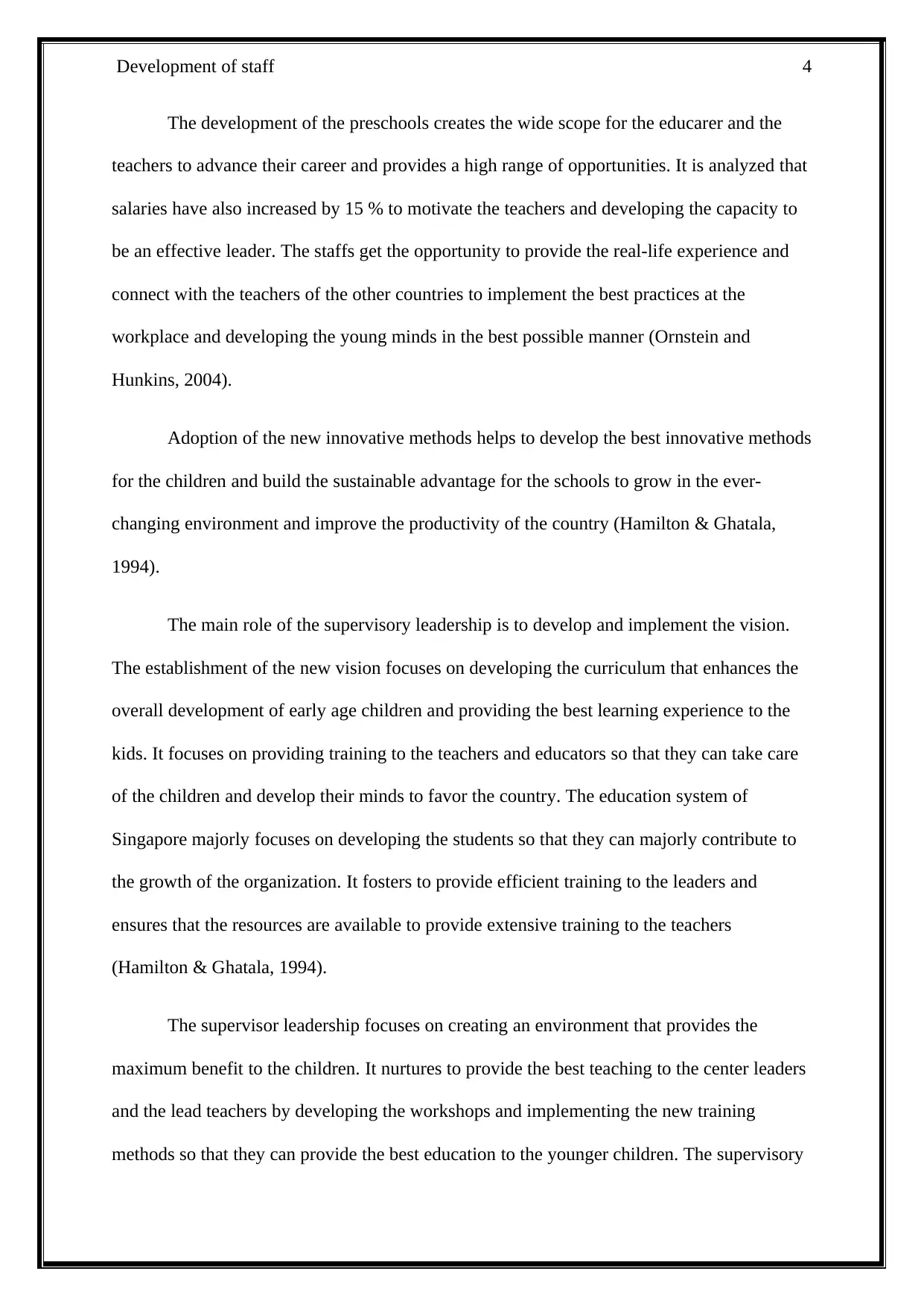
Development of staff 4
The development of the preschools creates the wide scope for the educarer and the
teachers to advance their career and provides a high range of opportunities. It is analyzed that
salaries have also increased by 15 % to motivate the teachers and developing the capacity to
be an effective leader. The staffs get the opportunity to provide the real-life experience and
connect with the teachers of the other countries to implement the best practices at the
workplace and developing the young minds in the best possible manner (Ornstein and
Hunkins, 2004).
Adoption of the new innovative methods helps to develop the best innovative methods
for the children and build the sustainable advantage for the schools to grow in the ever-
changing environment and improve the productivity of the country (Hamilton & Ghatala,
1994).
The main role of the supervisory leadership is to develop and implement the vision.
The establishment of the new vision focuses on developing the curriculum that enhances the
overall development of early age children and providing the best learning experience to the
kids. It focuses on providing training to the teachers and educators so that they can take care
of the children and develop their minds to favor the country. The education system of
Singapore majorly focuses on developing the students so that they can majorly contribute to
the growth of the organization. It fosters to provide efficient training to the leaders and
ensures that the resources are available to provide extensive training to the teachers
(Hamilton & Ghatala, 1994).
The supervisor leadership focuses on creating an environment that provides the
maximum benefit to the children. It nurtures to provide the best teaching to the center leaders
and the lead teachers by developing the workshops and implementing the new training
methods so that they can provide the best education to the younger children. The supervisory
The development of the preschools creates the wide scope for the educarer and the
teachers to advance their career and provides a high range of opportunities. It is analyzed that
salaries have also increased by 15 % to motivate the teachers and developing the capacity to
be an effective leader. The staffs get the opportunity to provide the real-life experience and
connect with the teachers of the other countries to implement the best practices at the
workplace and developing the young minds in the best possible manner (Ornstein and
Hunkins, 2004).
Adoption of the new innovative methods helps to develop the best innovative methods
for the children and build the sustainable advantage for the schools to grow in the ever-
changing environment and improve the productivity of the country (Hamilton & Ghatala,
1994).
The main role of the supervisory leadership is to develop and implement the vision.
The establishment of the new vision focuses on developing the curriculum that enhances the
overall development of early age children and providing the best learning experience to the
kids. It focuses on providing training to the teachers and educators so that they can take care
of the children and develop their minds to favor the country. The education system of
Singapore majorly focuses on developing the students so that they can majorly contribute to
the growth of the organization. It fosters to provide efficient training to the leaders and
ensures that the resources are available to provide extensive training to the teachers
(Hamilton & Ghatala, 1994).
The supervisor leadership focuses on creating an environment that provides the
maximum benefit to the children. It nurtures to provide the best teaching to the center leaders
and the lead teachers by developing the workshops and implementing the new training
methods so that they can provide the best education to the younger children. The supervisory
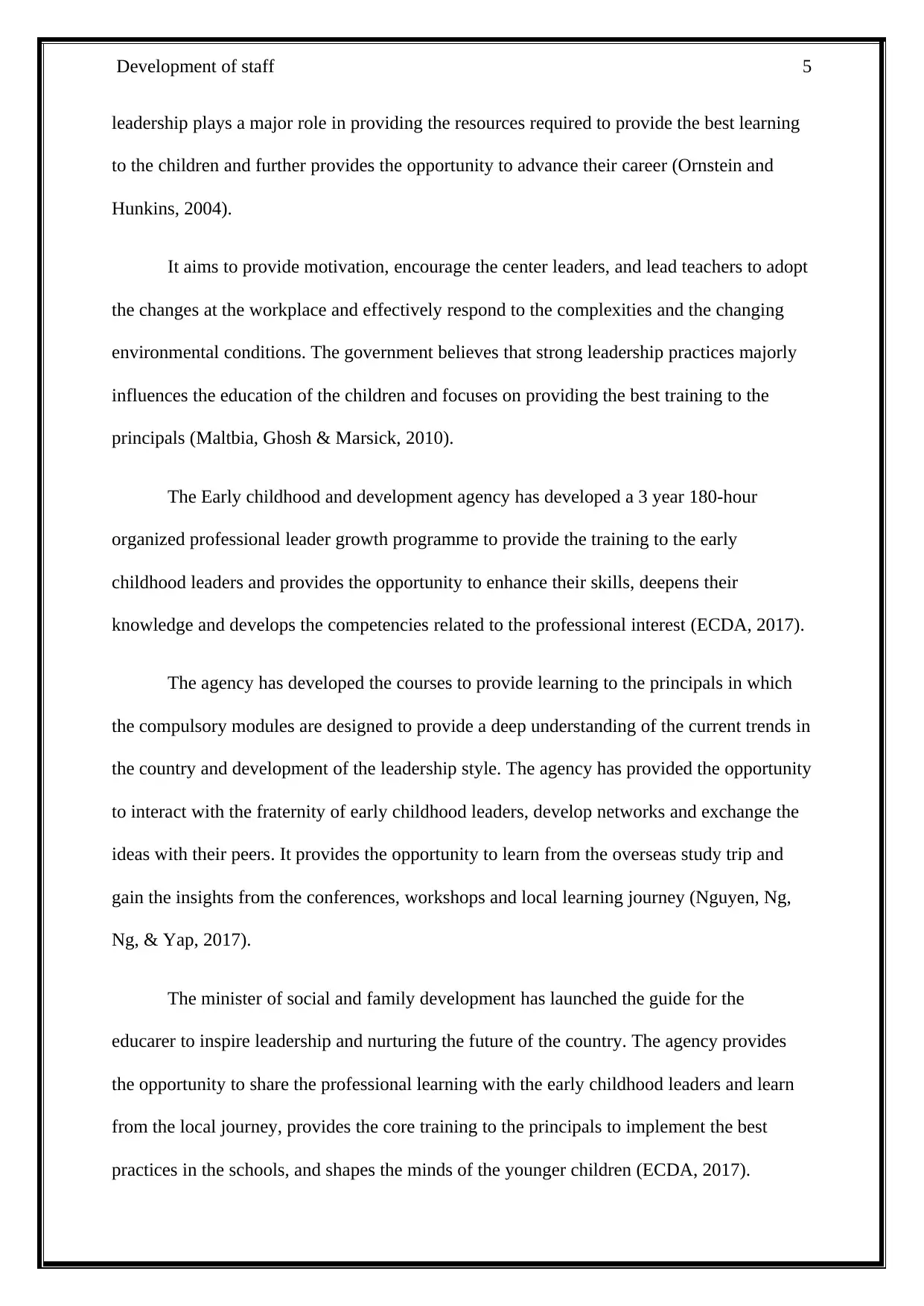
Development of staff 5
leadership plays a major role in providing the resources required to provide the best learning
to the children and further provides the opportunity to advance their career (Ornstein and
Hunkins, 2004).
It aims to provide motivation, encourage the center leaders, and lead teachers to adopt
the changes at the workplace and effectively respond to the complexities and the changing
environmental conditions. The government believes that strong leadership practices majorly
influences the education of the children and focuses on providing the best training to the
principals (Maltbia, Ghosh & Marsick, 2010).
The Early childhood and development agency has developed a 3 year 180-hour
organized professional leader growth programme to provide the training to the early
childhood leaders and provides the opportunity to enhance their skills, deepens their
knowledge and develops the competencies related to the professional interest (ECDA, 2017).
The agency has developed the courses to provide learning to the principals in which
the compulsory modules are designed to provide a deep understanding of the current trends in
the country and development of the leadership style. The agency has provided the opportunity
to interact with the fraternity of early childhood leaders, develop networks and exchange the
ideas with their peers. It provides the opportunity to learn from the overseas study trip and
gain the insights from the conferences, workshops and local learning journey (Nguyen, Ng,
Ng, & Yap, 2017).
The minister of social and family development has launched the guide for the
educarer to inspire leadership and nurturing the future of the country. The agency provides
the opportunity to share the professional learning with the early childhood leaders and learn
from the local journey, provides the core training to the principals to implement the best
practices in the schools, and shapes the minds of the younger children (ECDA, 2017).
leadership plays a major role in providing the resources required to provide the best learning
to the children and further provides the opportunity to advance their career (Ornstein and
Hunkins, 2004).
It aims to provide motivation, encourage the center leaders, and lead teachers to adopt
the changes at the workplace and effectively respond to the complexities and the changing
environmental conditions. The government believes that strong leadership practices majorly
influences the education of the children and focuses on providing the best training to the
principals (Maltbia, Ghosh & Marsick, 2010).
The Early childhood and development agency has developed a 3 year 180-hour
organized professional leader growth programme to provide the training to the early
childhood leaders and provides the opportunity to enhance their skills, deepens their
knowledge and develops the competencies related to the professional interest (ECDA, 2017).
The agency has developed the courses to provide learning to the principals in which
the compulsory modules are designed to provide a deep understanding of the current trends in
the country and development of the leadership style. The agency has provided the opportunity
to interact with the fraternity of early childhood leaders, develop networks and exchange the
ideas with their peers. It provides the opportunity to learn from the overseas study trip and
gain the insights from the conferences, workshops and local learning journey (Nguyen, Ng,
Ng, & Yap, 2017).
The minister of social and family development has launched the guide for the
educarer to inspire leadership and nurturing the future of the country. The agency provides
the opportunity to share the professional learning with the early childhood leaders and learn
from the local journey, provides the core training to the principals to implement the best
practices in the schools, and shapes the minds of the younger children (ECDA, 2017).
⊘ This is a preview!⊘
Do you want full access?
Subscribe today to unlock all pages.

Trusted by 1+ million students worldwide

Development of staff 6
The agency has developed the ECDA fellow programme to the new applicants to
implement the best practices. It recognizes the early childhood leaders and develops the
master class for the center leaders and the senior teacher. The agency provides the resources
to strengthen the learning’s of early childhood and provides the guidance to effectively
handle the needs of the young children (ECDA, 2017).
Another initiative implemented by the lien foundation in which it gears 150 preschool
principals for developing the future. It fosters to deliver effective training to the principals by
collaborating with the four international organizations. The foundation believed that the
principal is the most important source for implementing change in the schools and majorly
influences the growth of the children. It provides the experiential training with the overseas
exposure to learning from the best practices and provides the diversified opportunities to
explore and adopt in their schools (Lien Foundation, 2016).
The foundation has adopted the new competency model by interviewing 50 leaders
from different private preschools, business owners and the fellows from ECDA. The model is
developed on the basis on analyzation of the behavioral competencies. The foundation makes
the huge investment in providing the best training practices to the principals and guiding the
action of the principals to provide the best support to the preschools (Ng, 2015).
The programme focuses on analyzing the challenges faced by the principals in the
preschools and providing the remedies to effectively handle the complex and the changing
expectations of the parents and adopting the more inclusive approach towards the early age
children (Leithwood, Harris, & Hopkins, 2008).
Through the discussions on the above parts, it is deduced that the government of
Singapore adopts various measures to provide the opportunity to the principals to develop
their leadership capacity and implement the best practices in delivering higher learning
The agency has developed the ECDA fellow programme to the new applicants to
implement the best practices. It recognizes the early childhood leaders and develops the
master class for the center leaders and the senior teacher. The agency provides the resources
to strengthen the learning’s of early childhood and provides the guidance to effectively
handle the needs of the young children (ECDA, 2017).
Another initiative implemented by the lien foundation in which it gears 150 preschool
principals for developing the future. It fosters to deliver effective training to the principals by
collaborating with the four international organizations. The foundation believed that the
principal is the most important source for implementing change in the schools and majorly
influences the growth of the children. It provides the experiential training with the overseas
exposure to learning from the best practices and provides the diversified opportunities to
explore and adopt in their schools (Lien Foundation, 2016).
The foundation has adopted the new competency model by interviewing 50 leaders
from different private preschools, business owners and the fellows from ECDA. The model is
developed on the basis on analyzation of the behavioral competencies. The foundation makes
the huge investment in providing the best training practices to the principals and guiding the
action of the principals to provide the best support to the preschools (Ng, 2015).
The programme focuses on analyzing the challenges faced by the principals in the
preschools and providing the remedies to effectively handle the complex and the changing
expectations of the parents and adopting the more inclusive approach towards the early age
children (Leithwood, Harris, & Hopkins, 2008).
Through the discussions on the above parts, it is deduced that the government of
Singapore adopts various measures to provide the opportunity to the principals to develop
their leadership capacity and implement the best practices in delivering higher learning
Paraphrase This Document
Need a fresh take? Get an instant paraphrase of this document with our AI Paraphraser
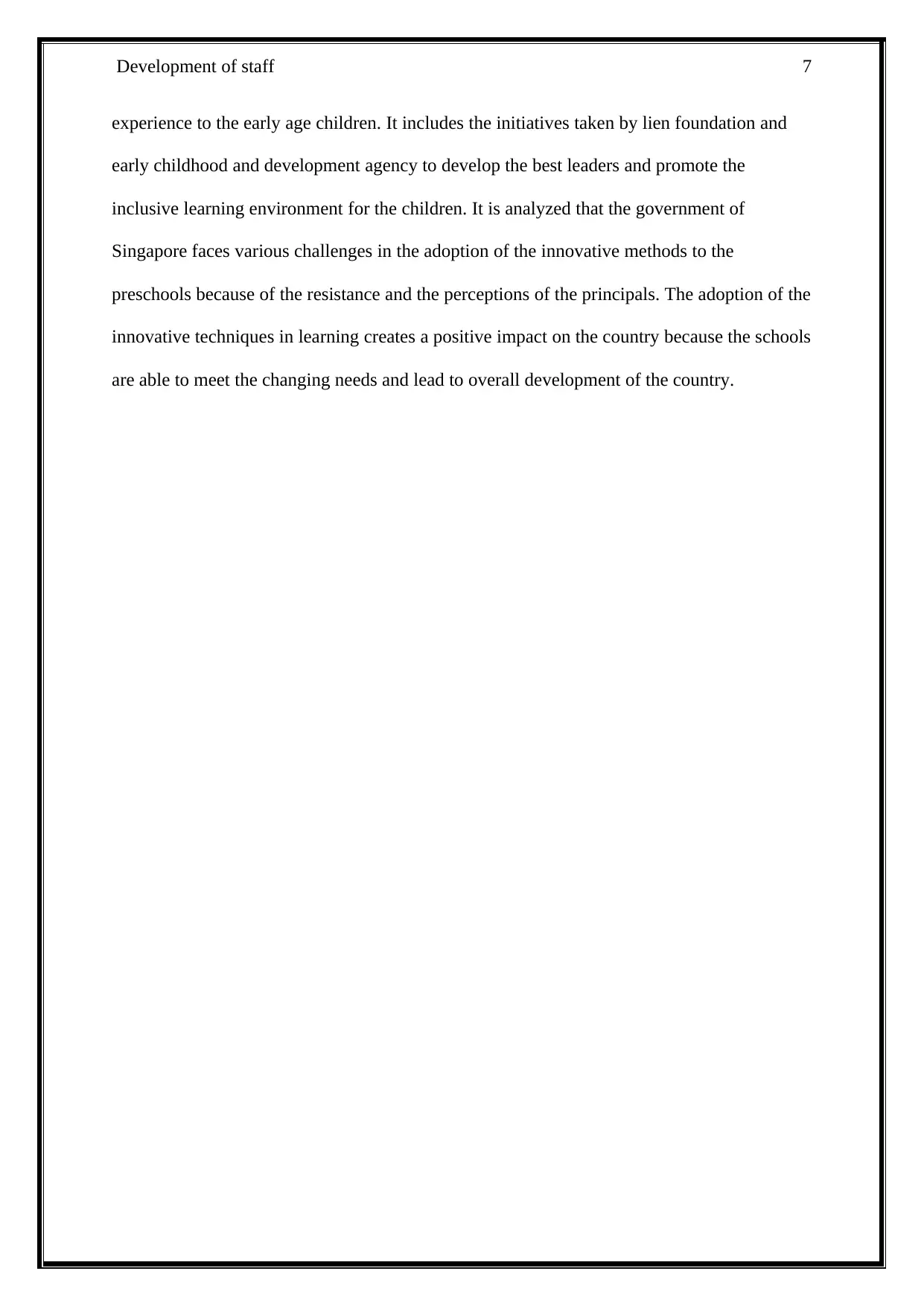
Development of staff 7
experience to the early age children. It includes the initiatives taken by lien foundation and
early childhood and development agency to develop the best leaders and promote the
inclusive learning environment for the children. It is analyzed that the government of
Singapore faces various challenges in the adoption of the innovative methods to the
preschools because of the resistance and the perceptions of the principals. The adoption of the
innovative techniques in learning creates a positive impact on the country because the schools
are able to meet the changing needs and lead to overall development of the country.
experience to the early age children. It includes the initiatives taken by lien foundation and
early childhood and development agency to develop the best leaders and promote the
inclusive learning environment for the children. It is analyzed that the government of
Singapore faces various challenges in the adoption of the innovative methods to the
preschools because of the resistance and the perceptions of the principals. The adoption of the
innovative techniques in learning creates a positive impact on the country because the schools
are able to meet the changing needs and lead to overall development of the country.
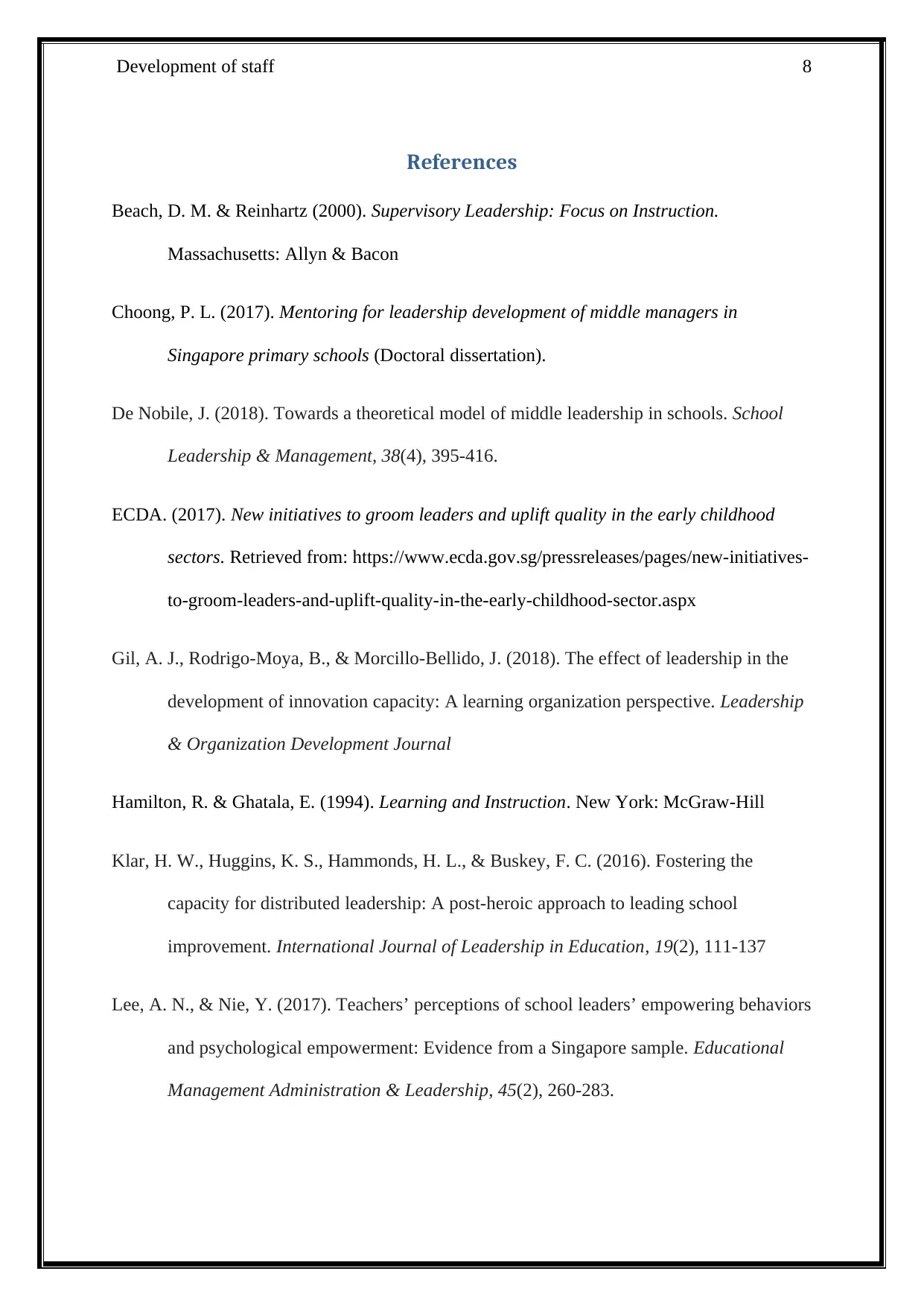
Development of staff 8
References
Beach, D. M. & Reinhartz (2000). Supervisory Leadership: Focus on Instruction.
Massachusetts: Allyn & Bacon
Choong, P. L. (2017). Mentoring for leadership development of middle managers in
Singapore primary schools (Doctoral dissertation).
De Nobile, J. (2018). Towards a theoretical model of middle leadership in schools. School
Leadership & Management, 38(4), 395-416.
ECDA. (2017). New initiatives to groom leaders and uplift quality in the early childhood
sectors. Retrieved from: https://www.ecda.gov.sg/pressreleases/pages/new-initiatives-
to-groom-leaders-and-uplift-quality-in-the-early-childhood-sector.aspx
Gil, A. J., Rodrigo-Moya, B., & Morcillo-Bellido, J. (2018). The effect of leadership in the
development of innovation capacity: A learning organization perspective. Leadership
& Organization Development Journal
Hamilton, R. & Ghatala, E. (1994). Learning and Instruction. New York: McGraw-Hill
Klar, H. W., Huggins, K. S., Hammonds, H. L., & Buskey, F. C. (2016). Fostering the
capacity for distributed leadership: A post-heroic approach to leading school
improvement. International Journal of Leadership in Education, 19(2), 111-137
Lee, A. N., & Nie, Y. (2017). Teachers’ perceptions of school leaders’ empowering behaviors
and psychological empowerment: Evidence from a Singapore sample. Educational
Management Administration & Leadership, 45(2), 260-283.
References
Beach, D. M. & Reinhartz (2000). Supervisory Leadership: Focus on Instruction.
Massachusetts: Allyn & Bacon
Choong, P. L. (2017). Mentoring for leadership development of middle managers in
Singapore primary schools (Doctoral dissertation).
De Nobile, J. (2018). Towards a theoretical model of middle leadership in schools. School
Leadership & Management, 38(4), 395-416.
ECDA. (2017). New initiatives to groom leaders and uplift quality in the early childhood
sectors. Retrieved from: https://www.ecda.gov.sg/pressreleases/pages/new-initiatives-
to-groom-leaders-and-uplift-quality-in-the-early-childhood-sector.aspx
Gil, A. J., Rodrigo-Moya, B., & Morcillo-Bellido, J. (2018). The effect of leadership in the
development of innovation capacity: A learning organization perspective. Leadership
& Organization Development Journal
Hamilton, R. & Ghatala, E. (1994). Learning and Instruction. New York: McGraw-Hill
Klar, H. W., Huggins, K. S., Hammonds, H. L., & Buskey, F. C. (2016). Fostering the
capacity for distributed leadership: A post-heroic approach to leading school
improvement. International Journal of Leadership in Education, 19(2), 111-137
Lee, A. N., & Nie, Y. (2017). Teachers’ perceptions of school leaders’ empowering behaviors
and psychological empowerment: Evidence from a Singapore sample. Educational
Management Administration & Leadership, 45(2), 260-283.
⊘ This is a preview!⊘
Do you want full access?
Subscribe today to unlock all pages.

Trusted by 1+ million students worldwide

Development of staff 9
Leithwood, K., Harris, A., & Hopkins, D. (2008). Seven strong claims about successful
school leadership. School leadership and management, 28(1), 27-42.
Lien Foundation. (2016). Principals matter – New leadership programme to gear up 150
preschool principals for the future. Retrieved from:
http://www.lienfoundation.org/sites/default/files/Presser%20Principal%20Matters
%20FINAL.pdf
Maltbia, T. E., Ghosh, R., & Marsick, V. J. (2010). Learning from Experience Through the
Executive Coaching Competencies of Listening and Questioning: Reviewing
Literature to Inform Practice and Future Research. In 2010 Academy of Human
Resource Development International Research Conference
Ng, D. F. S. (2015). Leadership learning for complex organizations. Cogent Education, 2(1),
1-30.
Ng, D. F. S., Nguyen, T. D., Wong, B. K. S., Choy, W. K. W. (2015). Instructional leadership
practices in Singapore. School Leadership & Management, 35(2)
Nguyen, D. T., Ng, D., Ng, D., & Yap, P. S. (2017). Instructional leadership structure in
Singapore: a co-existence of hierarchy and hierarchy. Journal of Educational
Administration, 55(2), 147-167.
Ornstein and Hunkins (2004). Chapter 8 Curriculum Design
Posner, G. J. (2004). Analyzing the Curriculum. Boston: McGraw Hill
Resnick, L. (1987). Learning in schools and out. Educational Research, 16(9), 13-20.
Trimmer, K., Donovan, J., Findlay, Y. S., & Mohamed, K. (2017). Master teachers as leaders
in school-based action research. Leading and Managing, 23(2), 1
Leithwood, K., Harris, A., & Hopkins, D. (2008). Seven strong claims about successful
school leadership. School leadership and management, 28(1), 27-42.
Lien Foundation. (2016). Principals matter – New leadership programme to gear up 150
preschool principals for the future. Retrieved from:
http://www.lienfoundation.org/sites/default/files/Presser%20Principal%20Matters
%20FINAL.pdf
Maltbia, T. E., Ghosh, R., & Marsick, V. J. (2010). Learning from Experience Through the
Executive Coaching Competencies of Listening and Questioning: Reviewing
Literature to Inform Practice and Future Research. In 2010 Academy of Human
Resource Development International Research Conference
Ng, D. F. S. (2015). Leadership learning for complex organizations. Cogent Education, 2(1),
1-30.
Ng, D. F. S., Nguyen, T. D., Wong, B. K. S., Choy, W. K. W. (2015). Instructional leadership
practices in Singapore. School Leadership & Management, 35(2)
Nguyen, D. T., Ng, D., Ng, D., & Yap, P. S. (2017). Instructional leadership structure in
Singapore: a co-existence of hierarchy and hierarchy. Journal of Educational
Administration, 55(2), 147-167.
Ornstein and Hunkins (2004). Chapter 8 Curriculum Design
Posner, G. J. (2004). Analyzing the Curriculum. Boston: McGraw Hill
Resnick, L. (1987). Learning in schools and out. Educational Research, 16(9), 13-20.
Trimmer, K., Donovan, J., Findlay, Y. S., & Mohamed, K. (2017). Master teachers as leaders
in school-based action research. Leading and Managing, 23(2), 1
1 out of 10
Related Documents
Your All-in-One AI-Powered Toolkit for Academic Success.
+13062052269
info@desklib.com
Available 24*7 on WhatsApp / Email
![[object Object]](/_next/static/media/star-bottom.7253800d.svg)
Unlock your academic potential
Copyright © 2020–2025 A2Z Services. All Rights Reserved. Developed and managed by ZUCOL.




